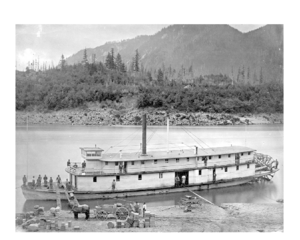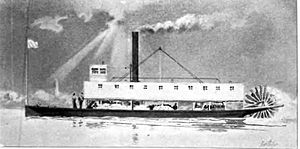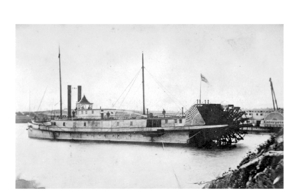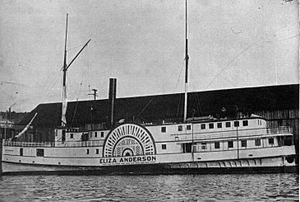Steamboats of the Lower Fraser River and Harrison Lake facts for kids
This article explores the exciting history of steamboats on the Lower Fraser River and Harrison Lake in British Columbia. The very first steamboat to reach the Pacific Ocean was the SS Beaver in 1835. It was like a floating store for the Hudson's Bay Company, traveling all around the lower Columbia River in Oregon and along the coasts of Washington, British Columbia, and even parts of Russian America (now Alaska). This was long before these places became the countries and states we know today!
Contents
Steamboats and the Gold Rush Era
The real boom for steamboats on the Fraser River began with the Fraser Canyon Gold Rush and the Cariboo Gold Rush in 1862. These gold rushes brought many more steamboats from the Columbia River in Oregon to places like Puget Sound and the Fraser River. Some of the famous ships that arrived were the Suprize, Enterprise, and the Wilson G. Hunt.
British Columbia's Early Shipping Rules
When the Fraser Canyon Gold Rush started, the Colony of British Columbia was officially created. The British colonial Governor, James Douglas, was concerned about American companies controlling all the trade in the new colony. To prevent this, he made a rule that stopped steamboats flying the American flag from doing business in British Columbia. This rule had two important effects:
- It helped a local shipbuilding industry grow.
- Some ship owners changed their flags and registered their ships as British to continue operating.
Key Steamboat Captains and Their Rivalries
Two very important shipping leaders emerged during this time: William Irving, an American from Portland, and William Moore, who was German but lived in the New World. Both of them became major players in the shipping business, often competing fiercely with each other through monopolies and "rate wars" where they tried to offer the lowest prices.
These steamboats, mostly powered by a large paddlewheel at the back (called sternwheelers), would travel about 120 kilometers (75 miles) up the river to towns like Yale and Hope. The Fraser River was easy to navigate up to Yale, but beyond that, the river became too wild for regular boats. Gold seekers wanted to travel from Victoria, a deep-sea port, by shallow steamboats. A Hudson's Bay fort at Fort Langley was about 30 miles (48 km) inland from the ocean. Regular steamboat service ran on the Fraser River all the way to Yale. Soon after, service also started on the Harrison River up to the top of Harrison Lake. Here, a town called Port Douglas became a key stop for travelers heading to the gold fields via the Douglas Road, also known as the Lakes Route or Lillooet Trail. This route used a series of lakes and wagon roads to reach Cayoosh Flat, another important gold rush town.
A Gold Rush Journey in 1862
A diary from the Cariboo Gold Rush gives us a glimpse into a traveler's journey:
- Tuesday, February 17, 1862: Left Southampton by steamer Shannon.
- April 26: Arrived in San Francisco after traveling through the Panama Isthmus.
- May 7: Arrived at Asquamalt, then walked to Victoria.
- May 12: Left Victoria on the Enterprise, arriving at New Westminster on the Fraser River.
- May 16: Left Westminster by Flying Dutchman, a small river steamer.
- May 17: Arrived at Harrison River at 8 AM. Left by Union, another small steamer.
- Got to Port Douglas at 7 PM.
- May 19: Left Douglas at 7 AM, carrying a 70-pound (32 kg) pack. The hills were steep and it was very hot.
- Crossed Seaton Lake in a boat called Chapman.
- Monday, May 20: Walked about 20 miles (32 km).
- June 8: Arrived at Quesnelle Forks.
Steamboats and the Canadian Pacific Railway
In 1881, the Canadian Pacific Railway began building a massive 3,000-mile (4,800 km) long railway from Montreal to Port Moody. To help with this huge construction project, special steamboats were built. The Skuzzy was built by Andrew Onderdonk to move supplies and became the only steamboat ever to travel through the challenging Fraser Canyon.
Once the railway opened in 1886, it became much easier to travel up the valley. Other railways, like the Grand Trunk Pacific and the Canadian Northern, later built their own steamboats to compete with the CPR. These competing railways used steamboats on the river to move rail barges (floating platforms for train cars). For example, the CN had the SS Canora, which moved boxcars from Port Mann to Victoria. The Great Northern Railway of Canada had a barge service from Port Guichon near Ladner to Sidney for its railway line. In the early years, the steam ferry Surrey also carried people and goods across the river, serving farmers from Liverpool to New Westminster.
A Long History of Steamboat Service
Steamboats provided regular service on the Fraser River for a very long time, from 1858 until 1981, when the last paddlewheel boat was retired. Small farms and remote communities along the river depended on these services for mail, delivering their produce and milk, and simply connecting across the very wide river where there were few bridges. Many communities relied on the steamboats, including Ladner, Anniedale, Liverpool, BC Penitentiary, Port Coquitlam, Hammond, Haney, Whonnock, Errock, Kilby, Pitt Lake, Stave Lake, Hayward Lake, Agassiz, Hope, Lulu Island, Queensborough, Barston Island, Deas Island, and Eburne.
Local Workers and Fuel Changes
The Indigenous people of the lower Fraser River, known today as the Sto:lo Coast Salish peoples, were often hired to cut firewood for the steamboats and work as deckhands. Their many years of experience navigating the river by canoe made them incredibly valuable. Later, steamboats began to burn coal, and even later, oil. Interestingly, steamboats were seen floating through the center of Chilliwack during major floods in both 1894 and 1948!
Goods Transported by River
The lower Fraser River is deep enough for large ocean-going ships. Freighters from all over the world would dock at places like Pacific Coast Terminals or Fraser Surrey docks to load up with forest products. This was in addition to the hundreds of sawmills that used to be located along the river. There were very large sawmills at Fraser Mills, Royal City, Western White Pine, and Queensborough, plus two pulp mills.
Tugboats and barges were also very common, and they were once 100 percent steam-powered. Fish products from Steveston, pulp and paper from Annacis Island, plywood, limestone, gravel, scrap metal, and cars were all moved by barge. While these types of steam-powered vessels were more part of the coastal shipping fleet than just river trade, they played a huge role in moving goods.
The Last Preserved Sternwheeler
The SS Samson V is a special boat because it's the only Canadian steam-powered sternwheeler that has been kept afloat and preserved. It was built in 1937 by the Canadian Federal Department of Public Works. Its job was to clear logs and debris from the lower parts of the Fraser River and to help maintain docks and navigation aids. The Samson V was the fifth "snagpuller" (a boat designed to remove underwater obstacles) on the Fraser River. It even uses engines, a paddlewheel, and other parts that were passed down from the Samson II, which was built in 1914! Today, the Samson V is a floating museum in its home port of New Westminster, near Vancouver, B.C.
Other Types of Steam-Powered Vessels
Many other kinds of steam-powered vessels worked on the river, including dredges, derricks, and cranes. In the early years, dikes, docks, and jetties needed to be built, so barge-based steamers were used for this work. Later, as many bridges, airports, and factories were constructed, cranes and dredges were essential. Companies like Fraser River Pile and Dredge and Dinsmore Dredge were involved in these projects. Derricks and snagboats also played a vital role in keeping the river clear and navigable.
Famous Fraser River Steamboats

Here is a list of some of the many steamboats that worked on the Fraser River and Harrison Lake:
- Alexandra
- Annacis
- Beaver
- Bailey Gatzert
- Blonde
- Brunette
- Colonel Moody
- Dauntless
- Elizabeth A. Irving
- Enterprise
- Essington
- Fearless
- Firefly
- Fort Hope
- Fort Yale
- Fullness
- Gertrude
- Gleeful
- Governor Douglas
- Gypsy
- Henrietta
- Hodder Tug
- Mighty Mite
- Onward
- Pacific Slope
- Peerless
- Queen
- Reliance
- R. P. Rithet
- Samson
- San Mateo
- Sea Bird
- Shuswap
- Skeena
- Skowlitz
- Surrey
- Swan
- Teaser
- Umatilla
- Western Slope
- William Irving
- Yale
- lilooet
- Hope






